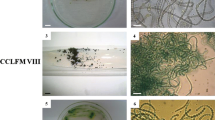Abstract
An apparatus for the continuous cultivation of sulfate-reducing microorganisms is described. The characteristics of the continuous process are discussed and a brief description is given of an iron-sulfide mineral formed in this bacteriological process.
Similar content being viewed by others
References
Abd-el-Malek, Y. andRizk, S. G. 1960. Culture ofDesulphovibrio desulphuricans. - Nature185: 635–636.
Berner, R. A. 1967. Diagenesis of iron sulfide in recent marine sediments. - Publ. Am. Assoc. Advan. Sci.83: 268–272.
Brown, A. S. 1934. A type of silver chloride electrode suitable for use in dilute solutions. - J. Am. Chem. Soc.56: 646–647.
Fencl, Z. 1963. A uniform system of basic symbols for continuous cultivation of microorganisms. - Folia Microbiol. (Praha)8: 192–194.
Fencl, Z. 1966. Theoretical analysis of continuous culture systems, p. 69–153.In I. Málek and Z. Fencl, (eds.), Theoretical and methodological basis of continuous culture of microorganisms. - Academic Press, New York and London.
Ghose, T. K. 1955. The influence of short-chain fatty acids, vitamins and some other factors on the sulphate-reduction in lactate cultures ofDesulphovibrio desulfuricans (Beijerinck) Kluyver et van Niel. - Schweiz. Z. Hydrol.17: 315.
Hallberg, R. O. 1967. Some factors of significance in the formation of sedimentary metal sulphides. - Stockh. Contr. Geol.15: 39–66.
Meynell, G. G. andMeynell, E. 1965. Theory and practice in experimental bacteriology. - Cambridge Univ. Press.
Postgate, J. 1964. Enrichment and isolation of sulphate-reducing bacteria, p. 190–197.In Anreicherungskultur und Mutantenauslese, Symposium, Göttingen. - Zentr. Bakteriol. Parasitenk., 1. Abt., Suppl. 1, Gustav Fischer, Stuttgart, 1965.
Postgate, J. R. andCampbell, L. L. 1966. Classification ofDesulfovibrio species, the nonsporulating sulfate-reducing bacteria. - Bacteriol. Rev.30: 732–738.
Starkey, R. L. 1938. A study of spore formation and other morphological characteristics ofVibrio desulfuricans. - Arch. Mikrobiol.9: 268–304.
ZoBell, C. E. 1946. Studies on redox potential of marine sediments. - Bull. Am. Assoc. Petrol. Geologists30: 477–513.
Author information
Authors and Affiliations
Additional information
I thank Professor I. Hessland, Director of the Geological Institute of the University of Stockholm, and Professor T. O. Wikén, Director of the Laboratory of Microbiology of the Delft University of Technology, for their invaluable advice during the course of this investigation.
For critical reading of the manuscript I am most grateful to Dr. D. T. Rickard, Stockholm.
The text-figures were prepared by Mr. H. Roos.
The financial support of The Natural Science Research Council and the Ore Foundation, Sweden, is gratefully acknowledged.
Rights and permissions
About this article
Cite this article
Hallberg, R.O. An apparatus for the continuous cultivation of sulfatereducing bacteria and its application to geomicrobiological purposes. Antonie van Leeuwenhoek 36, 241–254 (1970). https://doi.org/10.1007/BF02069026
Received:
Issue Date:
DOI: https://doi.org/10.1007/BF02069026



